European Commission
-
- Ocean Energy: A Surge Coming in 2020 Marine Technology, Jan 2020 #14
Ocean Energy Systems (OES) was launched in 2001 as a technology collaboration program of the International Energy Agency (IEA). It was created in response to increased ocean wave and tidal current energy activity primarily in Denmark, Portugal and the United Kingdom. The organization today consists of 25 members including specialists from government departments, national energy agencies, and research and scientific bodies. OES Chair Henry Jeffrey explains why the outlook for ocean energy advances looks particularly positive for 2020.
In recent months OES has recorded major progress across the ocean energy sector with global tidal projects achieving extensive operating hours and wave technology advancing in large-scale laboratory and offshore test sites. A growing range of devices are now being tested in open water through an increase of cross-border R&D projects supported by the European Commission.
These developments are documented in the OES 2019 Annual Report, which also reveals significant public and private sector investment earmarked for 2020. Marquee projects include $25m pledged by the US Department of Energy to support 12 ‘next-generation’ marine energy pilots and Wave Energy Scotland committing £7.7 million to two wave energy machines using the Stage Gate selection process. The European Commission is further investing in a broad set of initiatives and deployments.
OES is expecting to see many more positive advances in 2020 as governments around the world look to harness the power from the ocean.
A key function of OES is to provide a comprehensive overview of ocean energy policy, research and technology being implemented by member countries. One notable trend we are observing is a growing number of ‘cross-border’ R&D projects supported by European Union funding. These projects are increasing knowledge and understanding of device developments. The strengthened communication is also helping tackle pressing issues surrounding design and efficiency improvements, array configurations, environmental impacts and cost reduction.Strong progress is also being recorded across a number of OES collaborative strategic tasks. The OES ‘Task on Cost of Energy’ is being successfully used alongside the ‘Stage Gate Metrics Task’ to analyze historical trends, future developments and various nuances between technologies and countries. This work allows us to chart and monitor the evolution of ocean energy costs and assess the impact of different drivers.
It is widely recognized that a rigorous technical review approach is required across the ocean energy sector, making use of improved evaluation methods and metrics. OES has been working closely with US Department of Energy, Wave Energy Scotland and the European Commission to achieve an internationally accepted approach of performance metrics for ocean energy development. This will be of high value to technology developers, investors and funders.Meanwhile, the OES ‘Environmental Task’ is playing an important role continuing to collect, synthesize, and disseminate information. This provides access to knowledge and information related to research, monitoring, and evaluation of the environmental effects of ocean energy helping advance the industry. This task is supported by the publicly accessible online knowledge management system Tethys, developed by Pacific Northwest National Laboratory. Greater attention is however still required to assess potential job creation stimulated by the sector and to update projections for 2030 and 2050.
In recent years commercial interest in ocean energy has grown significantly at a global level. However, there are considerable investment costs and bottlenecks that need to be overcome. Globally, we are still waiting for clear market signals for ocean energy projects, which are vital for the industry to progress from demonstration to commercial projects. The ocean energy sector is at a crucial point where it must make best use of public funds, to deliver the right research, development and demonstration activity to build the confidence of the private investment community.
A great benefit of the OES network is that it enables nations to pool talent and resources to address global ocean energy challenges that no country can tackle alone. As an organization OES is firmly focused on uniting forces to advance research, development and demonstration of conversion technologies. Our underlying mission is to make ocean power a cost-effective, reliable and low-carbon source of energy generation for the whole world.OES was established by International Energy Agency which carries out a comprehensive program of energy co-operation for its member countries. It examines the full spectrum of energy issues and advocates policies that will enhance energy security, economic development, environmental awareness and engagement worldwide.
Author Biography - Henry Jeffrey
Henry Jeffrey is a specialist in ocean energy roadmaps, action plans and strategies. He is a co-director for SuperGen ORE (Offshore Renewable Energy) UKCMER and leads the Policy and Innovation Group in the University of Edinburgh’s Institute for Energy Systems. He also chairs the European Energy Research Alliance (EERA) Ocean Energy Joint Program (JP) and collaborates on numerous European ocean energy projects. He is the current Chair of the International Energy Agency’s (IEA) Ocean Energy Systems (OES) programme, which is a government policy group responsible for supporting knowledge exchange and collaboration between countries and organisations active in the ocean energy sector. -
- Bunker Industry Fueled by Word Affairs Maritime Reporter, May 2003 #56
even welcome the move, as it means more freight for them. Potentially more serious for the bunker business were the initial proposals by the European Commission to phase out all single hull tankers almost immediately. The proposal, as drafted, included all tankers over 600 dwt, which would have effectivel
-
- Shipbuilders Complain To EU About S. Korean Subsidies Maritime Reporter, Nov 2000 #16
at the World Trade Organization (WTO). The Committee of EU Shipbuilders' Associations (CESA) reported that it had filed a complaint with the European Commission under the EU's Trade Barriers Regulation over alleged trade distortions in global shipbuilding caused by South Korean aid to its industry
-
- IMO Orders Fuels of the Future Maritime Reporter, Nov 2017 #30
Oxide (SOx) limits and CO2 emissions. The International Maritime Organization (IMO) has updated the maximum amount of SOx allowed in fuels and the European Commission is introducing new reporting requirements to monitor CO2 emissions. Understanding the impacts of these changes on ship owners and operators
-
- IMO Orders Fuels of the Future Maritime Logistics Professional, Sep/Oct 2017 #17
Oxide (SOx) limits and CO2 emissions. The International Maritime Organization (IMO) has updated the maximum amount of SOx allowed in fuels and the European Commission is introducing new reporting requirements to monitor CO2 emissions. Understanding the impacts of these changes on ship owners and operators
-
- INTERTANKO Calls For "Reasoned Solution" In Wake Of Single Hull Phase Out Maritime Reporter, Nov 2000 #23
phaseouts was discussed at the 45th Session of IMO's Marine Environment Protection Committee (MEPC 45) in London on October 2-6, 2000. The European Commission's proposals on the accelerated phase out of single hull tankers was the most controversial of a series of three initiatives it launched
-
- GALILEO Lifts Off Maritime Reporter, Mar 2004 #52
The European Commission adopted a communication on progress on the GALILEO program. Less than two years after the launch of the project in March 2002 and less than six months after the actual setting up of the GALILEO joint undertaking, the Commission informed Parliament and the Council of progress
-
- EC: Spanish Shipyards Owe €308.3M Maritime Reporter, Jun 2004 #11
The Spanish shipbuilding establishment received a financial blow when the European Commission ruled last month that aid provided was not in line with EC rules on State aid to shipbuilding. In a nutshell, Izar owes 6 308.3 million, plus interest, a tall financial hurdle in the face of an already
-
- AUVs are Central to Lisbon Security Program Marine Technology, Jun 2014 #18
developed for the SUPPORT (Security UPgrade for PORTS) project, an integrated four-year research and development project, partially funded by the European Commission’s FP7 Security Research Program, were demonstrated at the Port of Lisbon on May 22. Coordinated by BMT Group Ltd. (BMT), SUPPORT has been exploring
-
- Maritime Surveillance: Autonomous and in Real-time Maritime Reporter, Aug 2015 #75
, coordinated by Spanish technological company Indra, is one of the most significant initiatives within the 7th Framework Program of the European Commission, and has constituted the flagship of R&D in the maritime security segment. In the project’s term, ended in June 2015, CMRE scientists and
-
- All Eyes on Ireland Marine Technology, May 2017 #34
Research partners, the Atlantic Ocean Coordination and Support Action, to support the implementation of the Galway Statement on behalf of the European Commission. “It can be seen that Ireland has invested heavily in building research and innovation capacity in ocean observation and other areas in
-
- Prestige - A Charterer's Reaction Maritime Reporter, Jun 2003 #44
. I know that Intertanko shares this view as well. It was reassuring to learn of the recent meeting between the IMO Secretary General and the European Commission vice president, in which they confirmed the importance of global standards for shipping. BP recognizes that age alone is not by itself a
-
 )
March 2024 - Marine Technology Reporter page: 33
)
March 2024 - Marine Technology Reporter page: 33that, like crude oil, nodules take millions of years to form, so biodiversity loss would essentially be permanent. And in Feb- ruary 2024, the European Parliament passed a resolution raising concerns about Norway’s mining intentions. www.marinetechnologynews.com 33 MTR #3 (18-33).indd 33 4/4/2024
-
 )
April 2024 - Maritime Reporter and Engineering News page: 43
)
April 2024 - Maritime Reporter and Engineering News page: 43. ship capacity substantially. ogy Platform, which provides policy “One response might be to build more Technology as Tool guidance to the European Commission ships, but even a shameless opportunist on maritime R&D. With industry in- “Technology should be helping to would acknowledge that this defeats
-
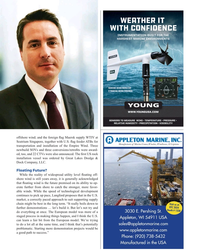 )
April 2024 - Maritime Reporter and Engineering News page: 23
)
April 2024 - Maritime Reporter and Engineering News page: 23to Visit us at OTC 2024 further demonstrations … let’s build it. But let’s not try and Booth # 1338 3030 E. Pershing St. do everything at once. The European model was more of a staged process in making things happen, and I think the U.S. Appleton, WI 54911 USA can learn a fair bit from the European model
-
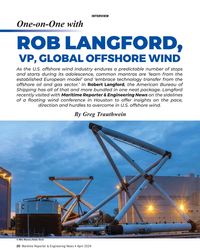 )
April 2024 - Maritime Reporter and Engineering News page: 20
)
April 2024 - Maritime Reporter and Engineering News page: 20the U.S. offshore wind industry endures a predictable number of stops and starts during its adolescence, common mantras are ‘learn from the established European model’ and ‘embrace technology transfer from the offshore oil and gas sector.’ In Robert Langford, the American Bureau of Shipping has all of that
-
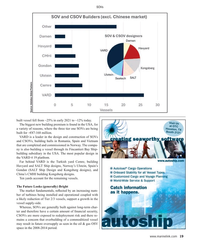 )
April 2024 - Maritime Reporter and Engineering News page: 19
)
April 2024 - Maritime Reporter and Engineering News page: 19SOVs Source: Intelatus Global Partners built vessel fell from ~25% in early 2021 to ~12% today. Visit Us The biggest new building premium is found in the USA, for at OTC Houston, TX a variety of reasons, where the three tier one SOVs are being Booth 2121 built for ~€87-168 million. VARD is a leader in
-
 )
April 2024 - Maritime Reporter and Engineering News page: 18
)
April 2024 - Maritime Reporter and Engineering News page: 18the million (2021) to €66 million (2024). In the same period, a North and Mid-Atlantic, to the Paci? c Coast and the Gulf Chinese built CSOV for the European market would attract of Mexico, effectively creating three-four sub segments for a yard price of €44 million (2021) and €61 million (2024). SOV/CSOV
-
 )
April 2024 - Maritime Reporter and Engineering News page: 17
)
April 2024 - Maritime Reporter and Engineering News page: 17that one can make is that more turbines will drive the demand for more Tier 1 SOVs and CSOVs. Until now demand Tier 1 vessels in the maturing European offshore wind segment has been driven by scale, more wind turbines, wind farms being built further offshore, clustering of developer projects
-
 )
April 2024 - Maritime Reporter and Engineering News page: 16
)
April 2024 - Maritime Reporter and Engineering News page: 16MARKETS SOVs – Analyzing Current, Future Demand Drivers By Philip Lewis, Director of Research, Intelatus © Björn Wylezich/AdobeStock t a high-level, there are three solutions to transferring Lower day rate CTVs are often used for daily transfer of technicians from shore bases to offshore wind farms
-
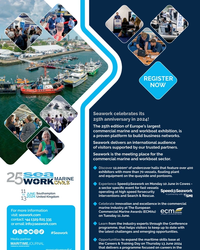 )
April 2024 - Maritime Reporter and Engineering News page: 7
)
April 2024 - Maritime Reporter and Engineering News page: 7with TO interventions and Search & Rescue. United Kingdom ???? 13 Celebrate innovation and excellence in the commercial marine industry at The European For more information (SQQIVGMEP2EVMRI&[EVHW *(2&W visit: seawork.com on Tuesday 11 June. contact: +44 1329 825 335 Learn from the industry
-
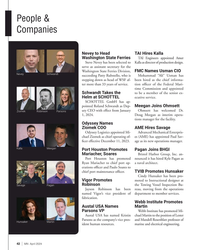 )
April 2024 - Marine News page: 42
)
April 2024 - Marine News page: 42People & Companies Nevey to Head TAI Hires Kalla Washington State Ferries TAI Engineers appointed Amer Steve Nevey has been selected to Kalla as director of production design. serve as assistant secretary for the FMC Names Usman CIO Washington State Ferries Division, Nevey Schwandt succeeding Patty
-
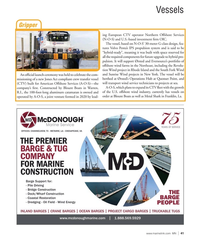 )
April 2024 - Marine News page: 41
)
April 2024 - Marine News page: 41Vessels Gripper ing European CTV operator Northern Offshore Services (N-O-S) and U.S.-based investment ? rm OIC. The vessel, based on N-O-S’ 30-meter G-class design, fea- tures Volvo Penta’s IPS propulsion system and is said to be “hybrid-ready”, meaning it was built with space reserved for all the
-
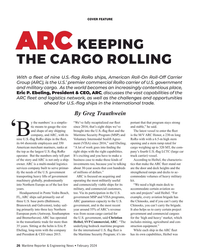 )
February 2024 - Maritime Reporter and Engineering News page: 26
)
February 2024 - Maritime Reporter and Engineering News page: 26, you can’t carry the brigade. ing primarily into three key Northern year around 55% of ARC’s revenue It also helps us to carry certain project European ports (Antwerp, Southampton was from ocean cargo carried for government and commercial cargoes and Bremerhaven). ARC has operated the U.S. government
-
 )
February 2024 - Maritime Reporter and Engineering News page: 22
)
February 2024 - Maritime Reporter and Engineering News page: 22R&D MATT HART Matt Hart, Manager & Platform Leader, Marine & Stationary Power Systems, Wabtec, offers insights on how the megatrends of decarbonization, energy transition and autonomy all inspire Image courtesy Wabtec and impact the marine power solutions from Wabtec. By Greg Trauthwein Matt, to start
-
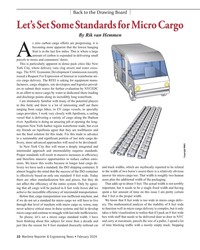 )
February 2024 - Maritime Reporter and Engineering News page: 10
)
February 2024 - Maritime Reporter and Engineering News page: 10Back to the Drawing Board Let’s Set Some Standards for Micro Cargo By Rik van Hemmen s zero carbon cargo efforts are progressing, it is becoming more apparent that the lowest hanging fruit is in the last few miles. This is where a large amount of carbon is expended in delivering small A parcels to
-
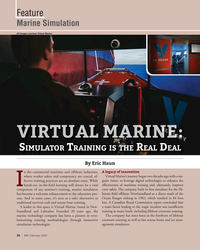 )
February 2024 - Marine News page: 34
)
February 2024 - Marine News page: 34Feature Marine Simulation All images courtesy Virtual Marine S T R DIMULATOR RAINING IS THE EAL EAL By Eric Haun A legacy of innovation n the commercial maritime and offshore industries, where worker safety and competency are crucial, ef- Virtual Marine’s journey began two decades ago with a sin- fect
-
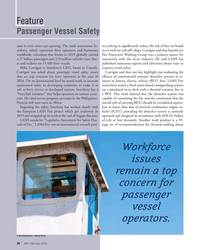 )
February 2024 - Marine News page: 26
)
February 2024 - Marine News page: 26should be considered equiva- Regarding ? re safety, Interferry has worked closely with lent or lower than that of internal combustion engine ve- the European LASH Fire project which got underway in hicles (ICEV), providing the drencher system is correctly 2019 and wrapped up its work at the end of August
-
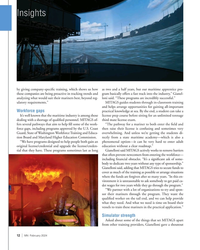 )
February 2024 - Marine News page: 12
)
February 2024 - Marine News page: 12by giving company-speci? c training, which shows us how as two and a half years, but our maritime apprentice pro- these companies are being proactive in tracking trends and gram basically offers a fast track into the industry,” Gianel- analyzing what would suit their mariners best, beyond reg- loni said.
-
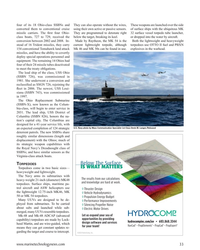 )
January 2024 - Marine Technology Reporter page: 33
)
January 2024 - Marine Technology Reporter page: 33four of its 18 Ohio-class SSBNs and They can also operate without the wires, These weapons are launched over the side converted them to conventional cruise using their own active or passive sensors. of surface ships with the ubiquitous MK missile carriers. The ? rst four Ohio- They are programmed to
-
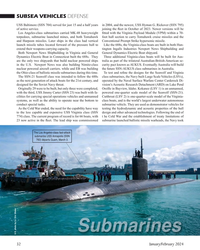 )
January 2024 - Marine Technology Reporter page: 32
)
January 2024 - Marine Technology Reporter page: 32SUBSEA VEHICLES DEFENSE USS Baltimore (SSN 704) served for just 15 and a half years in 2004, and the newest, USS Hyman G. Rickover (SSN 795) of active service. joining the ? eet in October of 2023. Newer versions will be Los Angeles-class submarines carried MK-48 heavyweight ? tted with the Virginia
-
 )
January 2024 - Marine Technology Reporter page: 31
)
January 2024 - Marine Technology Reporter page: 31at depths up to 1,000 feet. serve as a moored training ship (MTS ton. Some of the 688s were pulled from Hammerhead consists of a mooring 701) and the Nuclear Power School service at their mid-life point rather than module that plants itself on the bot- in Charleson, S.C. Likewise USS San incur the
-
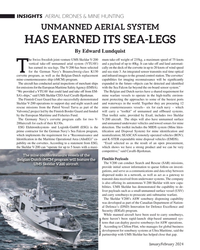 )
January 2024 - Marine Technology Reporter page: 12
)
January 2024 - Marine Technology Reporter page: 12The aircraft has conducted aerial inspections of merchant ships expanded in the future--objects can be detected and identi? ed for emissions for the European Maritime Safety Agency (EMSA). with the Sea Falcon far beyond the on-board sensor system.” “We provided a VTUAV that could land and take off from
-
 )
January 2024 - Maritime Reporter and Engineering News page: 40
)
January 2024 - Maritime Reporter and Engineering News page: 40In the Shipyard Latest Deliveries, Contracts and Designs Vard Inks $450M to Build Cable Layers ARD won a $252m contract for the design and con- struction of a third cable laying vessel for Italy’s Prysmian Group: Monna Lisa is still under construc- V tion; Leonardo da Vinci was delivered in 2021. The new
-
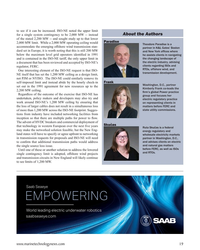 )
November 2023 - Marine Technology Reporter page: 19
)
November 2023 - Marine Technology Reporter page: 19so that there are multiple paths for power to ? ow. The advent of HVDC breakers and commercial deployment of Skucas that technology in western European over the next ? ve years Ruta Skucas is a federal may make the networked solution feasible, but the New Eng- energy regulatory and land states
-
 )
November 2023 - Marine Technology Reporter page: 18
)
November 2023 - Marine Technology Reporter page: 18LEGAL BEAT OFFSHORE WIND point in between, is an at least hourly calculation involving ue? ed natural gas gasi? cation facility, and the region’s two a control-to-control room check. The 1,200 MW value does remaining nuclear plants, Seabrook in New Hampshire and not appear in the 1991 agreement, but is
